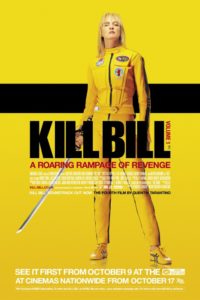Kill Bill: Volume 1
Kill Bill: Volume 2
5/5
Years ago, I was struggling to pinpoint exactly what it was that all the best movies have in common. The concept of “best movies” is subjective, so I figured there must be some similarities among the films that I deem “the best.”
Then the word “bombast” floated into my head, and I knew that that was it—the larger-than-life quality; the spectacle for the sake of spectacle; the guts to do something different, possibly even corny and usually out of the norm, and not be stifled by a self-conscious fear of what other films are doing.
Bombastic films are made for entertainment, not just message or style. Kill Bill (Volume 1 and 2, 2003 and 2004, respectively, referred to in this review as the singular Kill Bill) is wholly in this vein of filmmaking and is therefore one of the most fun, explosive, over-the-top—bombastic—films Quentin Tarantino has ever made.
So, for a time I was satisfied with my description of “bombast” until I actually looked it up and realized that, in fact, it was a misleading term, and that “ostentatious” would be more fitting to my needs. “Bombast” was perhaps more of an onomatopoeic fit than a literal translation of what I wanted to describe.
Kill Bill, while definitely over-the-top and a parody of its martial-arts/Western ancestors (being a postmodern film, it could be seen as insincere, but to go into why it actually is sincere would require more space than I have here), isn’t meaningless or devoid of high or low emotion. Kill Bill’s penultimate scene, for example, is devastating, despite the fact that the lead-up to it is filled with seriously questionable (though nonetheless exhilarating) fight scenes, chase scenes, comic-book dialogue, contrapuntal flute playing, and yellow leather tracksuits.
This is a perfect example of how “bombastic” films work: they’ll employ a word that doesn’t completely work descriptively, and they’ll use it anyway because it sounds great. Sure, you could poke holes in the word’s use, but you could also choose to sit back and enjoy it for its auditory advantages—the same goes for flutes and tracksuits.
Perhaps it’s the fury of my youth that draws me to Kill Bill like a moth to flame—its exuberance in execution, its seemingly un-plumbable wealth of ideas, its atypical female lead (Uma Thurman) blazing a path of carnage on a mission of righteous revenge—everything is awesome (literally) and bombastic (figuratively).

